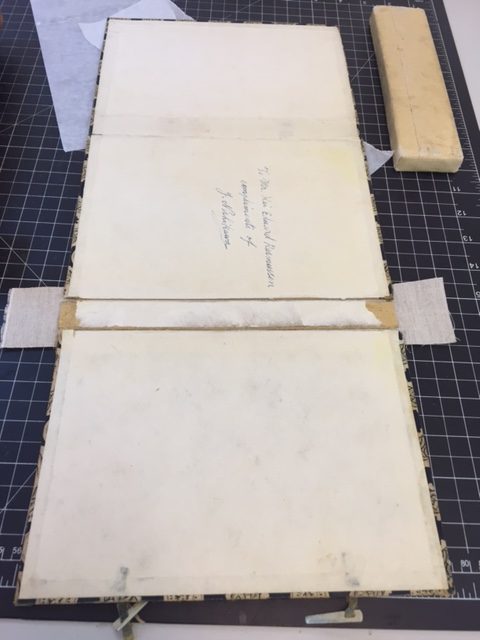
A few months ago, a book from the Freer Gallery of Art and Arthur M. Sackler Gallery Library came for treatment to the Book Conservation Lab: Home Life in Tokyo. Our copy, printed in 1911, is a softback binding, common for Japanese publications, and according to the bibliographic record, it was “issued in a portfolio.”

The book itself was in very good condition, however, after many years of protecting the soft-backed book, the portfolio enclosure had become damaged and was no longer functional. One spine piece of the structure had completely failed at its hinges; the decorative printed cloth and the paper linings had broken. The spine cloth fortunately was saved and sent along with the item.
I was able to gently lift the cloth edges off the adjacent boards of the portfolio and lay in a strip of archival linen underneath to create a new, and stronger, spine structure. I was able to re-adhere the saved spine cloth over the new linen lining, making sure to align it along the decorative pattern.

I then reattached the original strip of structural board to the inside of the new lining.

Then, gently delaminating the paper on the inside of the portfolio from the cover board, careful not to tear or damage it any further, I was able to “turn-in” the linen and original cloth by carefully tucking-in the cloth under the paper “pastedown.”

Though the entire structure, including the soft-back book, is made of very soft and thin materials, both the paper and the printed cloth of the portfolio remain in good and strong condition. This was helpful while I worked to lift and delimitate them from the underlying structural board.
Once the linen and cloth turndowns were tucked-in and adhered using wheat starch paste, I used conservation Japanese paper (very similar to the original paper used throughout, matching in texture and weight of the original pastedowns,) to cover the inside of the repair.

In the end, I was able to save both the protective portfolio’s ability to function robustly, as well as saving the original decorative cloth.

When I looked up the bibliographic information for this book as I prepared this post, I was pleased to see it has already been checked out again to a researcher—useful and useable.

Be First to Comment